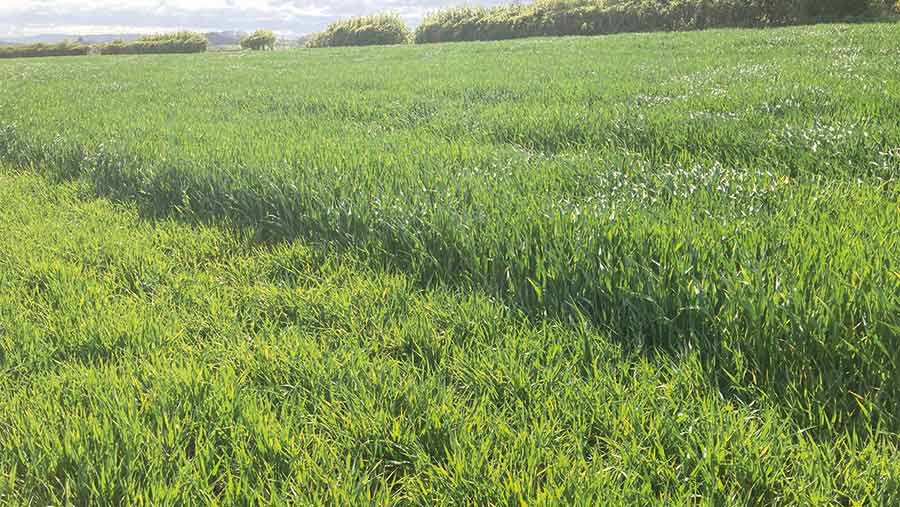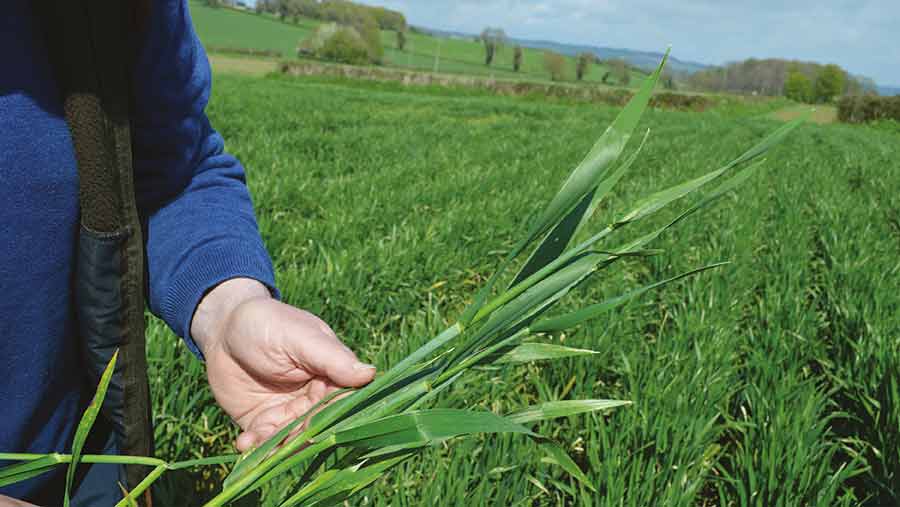Soil virus prompts move to resistant winter barley variety
 Sensation and Orwell barley varieties growing side-by-side © MAG/David Jones
Sensation and Orwell barley varieties growing side-by-side © MAG/David Jones Soil-borne viruses have pushed a light land Somerset farm into growing only one variety of winter barley and one of winter wheat, which are resistant to the yield-damaging mosaic virus, after suffering big yield losses.
Winter barleys in patches of the farm were seeing yield reduction of up to 50%, and the patches got bigger every year as strain 2 of Barley Yellow Mosaic Virus (BaYMV) took a firm hold, while another virus started to affect winter wheat crops.
See also: New barley virus strain puts resistant varieties at risk
Independent agronomist Stephen Harrison helped identify the problem as strain 2 of the virus, which is less well documented than strain 1.
All winter barley varieties on the current AHDB Recommended List are resistant to strain 1, but only a few are resistant to strain 2.
Stephen, of South West Agronomy, which covers Somerset, west Wiltshire and south Wales, says the virus strain appears to like free-draining light land where barley has been grown heavily in the past, and he has moved to growing the six-row conventional winter barley variety Sensation, as it is resistant to strain 2 of the virus.
“This is the fourth year of growing Sensation on the farm, and we are not seeing the virus affect the winter barley,” he tells Farmers Weekly.
Persistent virus
The first symptoms of this soil-borne virus are small yellow patches which appear in the crop from February, and are similar to crops suffering from waterlogging or acidity.
The virus can persist in the soil for many years and affects most winter-sown varieties, but not spring-sown cereals.
The barley leaves develop a streaky yellow look, brown at the tips, and often have in-rolling leaves leading to a spiky appearance, with these symptoms first showing in the early spring, especially after a prolonged cold spell.
The yellow streaks can become brown or purple at the leaf tip, and brown flecking may replace the yellow streaking.
The infection occurs in distinct patches, where the plants are stunted and mature late, and the patches increase in size in successive years.
The virus is spread by a root-infecting fungus, so moving soil will spread the virus through the field. Yield losses can range between 10-90%.
Control is only by resistance varieties and crop rotation, while there is no chemical treatment available.

Barley variety Sensation © MAG/David Jones
Resistant varieties
Strain 1 of the virus has been dominant in the UK, so the RYM4 resistance in current varieties has been effective, while RYM4 and also RYM5 resistance to strain 2 is only present in two varieties – the six-row Sensation from breeders DSV and the two-row Valerie from Senova – the former is not on the AHDB Recommended List while the latter is on the list.
Stephen says that the Somerset farm was growing the popular two-row winter barley variety Orwell and the virus was getting worse, but the switch to growing Sensation revived yields and caused the virus to virtually disappear and allow for winter barley to continue to be grown.
All 40ha of winter barley this year are down to Sensation.
Yields are now back to pre-mosaic levels of about 8t/ha for an important crop on the farm’s light soils, as lower inputs mean it can compete strongly with winter wheat on profitability.
While the variety can give low specific weights, barley on the Somerset farm has always been above the feed compounder minimum standard of 63kg/hl, generally averaging about 64kg/hl.
Stephen describes the variety as “leggy and weak strawed” similar to six-row winter barley Plaisant, which was grown in the 1980s, and says he has moved to a three-spray fungicide regime from a two-spray programme due to the increased pressure from ramularia.
The other variety showing resistance to strain 2 BaYMV Valerie is not favoured on the Somerset farm as it tends to be susceptible to ramularia, he says.
Fungicide programme
His three-spray programme for Sensation includes a late tillering (GS30) treatment of the SDHI-azole product Ascra (SDHIs bixafen + fluopyram + azole prothioconazole) along with Canopy (prohexadione + mepiquat chloride) as a plant growth regulator, with prothioconazole especially effective on rhynchosporium and fluopyram on net blotch.
At the GS37/38 flag leaf half emerged stage, Revystar (SDHI fluxapyroxad + azole mefentrifluconazole) is applied primarily against ramularia although it gives broad spectrum disease control, and again the PGR Canopy.
While at the early ear emergence (GS59) stage, Comet (pyraclostrobin) for brown rust and prothioconazole for topping up general disease control are applied.
He points out that fungicide spend is about £85/ha for winter barley compared with a winter wheat variety like Mayflower at £100/ha, while there is a nitrogen saving of 60kg/ha, with winter barley receiving 160kg/ha compared with wheat on 220kg/ha.
“On these light soils winter barley is cheaper to grow and is less risky than winter wheat,” he says.
Barley yields
Even though winter wheat yields might average 9t/ha against winter barley’s 8t/ha, with lower inputs and more valuable straw in a livestock area it makes the two very comparable on a profit basis, and winter barley is often grown as a first cereal on these light soils.
In addition, the conventional six-row feed barley is tolerant to another virus – the aphid-spread Barley Yellow Dwarf Virus (BYDV), and Stephen adds that the farm has never had to used an autumn insecticide in the four years of growing Sensation.
Other conventional six-row winter barleys have shown BYDV tolerance, such as Amistar and Rafaela, with the latest being Feeris which is on the current AHBD Recommended List.
Winter barley can see yield losses of up to 50% from BYDV attacks. This disease tends to be more prevalent in areas with mild winters, such as south and south-west England, but it can affect all crops of winter barley and wheat
The neonicotinoid seed dressing ban on cereals from autumn 2019 meant that growers had to choose between drilling later to avoid the aphid migration, or rely of pyrethroid sprays which were becoming less effective, prompting growing interest in tolerant varieties.
In addition, the farm’s light soils showed the presence of another soil-borne mosaic virus some two seasons ago and the farm has moved away from growing susceptible varieties, such as the popular Group 2 milling variety Extase, towards a similar Group 2 variety, Mayflower, which has resistance to the virus.
All 35ha of winter winter on the farm are down to the variety this season to try to overcome the virus problem.
Mayflower’s breeder Elsoms point out the variety includes genes conferring resistance to soil-borne wheat mosaic virus.
The variety also has the second-highest septoria disease resistance rating on the Recommended List, after Theodore.

